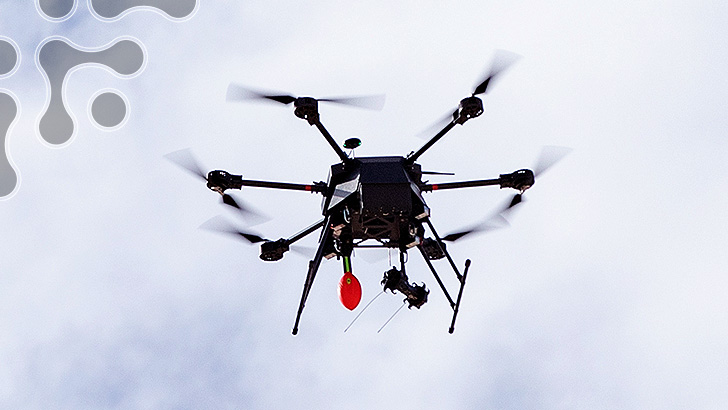

By Daniel Smoot and Hawa Jack, Army Innovation Programs
WASHINGTON – The U.S. Army Small Business Innovation Research and Small Business Technology Transfer Program leveraged their relationship with Orbital Research’s state-of-the-art drone weaponization systems to enable the Army to deliver innovative solutions that boost Soldier performance and resolve critical mission challenges in utilizing aerodynamics and advanced control systems.
Specializing in precision guidance systems, miniature actuators and sensors, and unmanned aerial vehicle kits, Orbital Research received Army SBIR investments to refine a hunt-kill-return system with drop-glide munitions. The Army SBIR funding enabled Orbital Research to collaborate with Soldiers to test and refine the system at live experimentation events. The system includes key components like fuses for releasable munitions, a motion measurement package for guided and unguided munitions, a common tail section for multiple purpose-built warheads, and a modular payload release system for converting single-use drones into multi-mission drones with lethal assets.
“We talked to Soldiers at Fort [Benning], and they said they needed munitions to defeat ambush positions and armored vehicles,” said Dr. Fred Lisy, president of Orbital Research. “Based on their feedback, we started building interchangeable warheads for the drop-glide munitions.”
With purpose-built warheads based on Soldier feedback, Orbital Research modified its HKR system to provide real-time detection and geolocation of multiple enemy threats. The collaborative process allowed the company to iterate on the HKR system, propelling it on a pathway to secure additional funding for further development.
In September 2022, the Office of the Under Secretary for Research and Engineering awarded Orbital Research over $9 million through the Accelerate the Procurement and Fielding of Innovative Technologies Program. Orbital used this funding to procure and conduct Soldier assessments of 1,700 drop-glide munitions and 24 UAVs with weapons release systems, leveraging the SBIR Phase III authority. By leveraging the SBIR Phase III authority, which allows federal agencies to award contracts to firms that successfully completed SBIR Phase I and Phase II efforts, Orbital worked to develop these innovations for widespread use. The Soldier assessments funded by the APFIT Phase III contract enabled Orbital to enhance the technology’s capabilities and refine Soldier training, operations and tactics with the HKR system.
Recognizing the continued value of Soldier feedback, the company iterated on its technology through Soldier touchpoint exercises, including the Army Expeditionary Warrior Experiment hosted by the Maneuver Center of Excellence at Fort Benning. During AEWE 2023, 2024 and 2025, Soldiers operated Orbital Research’s HKR system in tactical force-on-force exercises held by the Maneuver Center of Excellence’s Maneuver Battle Lab. The company’s participation in persistent experimentation events provided an opportunity to drop live rounds on military ranges and allowed Orbital Research to further test, adjust and retest its system, leading to significant advancements in its low-cost drop-glide munitions.
“I am very happy to say that our partnership with the Maneuver Battle Lab allowed us to mature the drop-glide munitions through releasing these rounds on their ranges,” Lisy said. “We can’t do that in commercial airspace, so working with the Battle Lab was invaluable.”
The combination of the contract awards, collaborations and experimentation positioned Orbital Research to secure an Army SBIR|STTR CATALYST contract in May 2024. The Army SBIR CATALYST Program unites small businesses with prime technology integrators and Army customers to accelerate and transition innovative small business technologies into Army programs of record. These contracts also helped Orbital Research to expand its connections and begin developing a networked lethality decision aid and weaponized Unmanned Aircraft System with the Army Combat Capabilities Development Command Armament Center. This kit allows one Soldier to operate a lethal network of UASs to outmatch adversaries while staying out of harm’s way.
“The Army SBIR|STTR Program has been invaluable to us, and we wouldn’t have made such great progress on cutting-edge technologies without the program,” Lisy said. “In that same vein, the SBIR CATALYST Program literally fused all our previous SBIR|STTR technologies together into one unified system.”
Orbital Research’s involvement in the Army SBIR|STTR, APFIT, and SBIR CATALYST programs continues to propel successful partnerships that yield critical technology for the Army. In early 2025, following the Army’s approved directed requirement for a company-level small UAS to support brigade combat teams, Orbital Research adapted its payload release system to integrate into multiple UAS platforms. Moving forward, Orbital Research plans to weaponize drones with its modular payload release system and drop-glide munitions, directly addressing critical Army needs through continued implementation of vital Soldier feedback and connections made through the Army SBIR|STTR Program.
Army SBIR actively releases funding opportunities, including Phase I funding for commercially viable, feasible, and technically sound solutions. Firms with mature technologies that meet Phase I requirements can progress to Phase II or begin directly with Direct to Phase II contracts. Army experts in technical, acquisition, and operational fields guide businesses to align their innovations with the Army’s critical needs throughout the process.
Army STTR integrates small businesses into the Army innovation ecosystem by coordinating with universities, federally funded research and development centers, or qualified non-profit research institutions. Small businesses serve as prime contractors, performing at least 40% of the work, while research partners complete at least 30%.
ASA(ALT) leverages innovative technologies to give Soldiers a decisive advantage in any environment by developing, acquiring, fielding, and sustaining the world’s finest equipment and services. For more information, visit the ASA(ALT) web page and follow @ArmyASAALT.
Subscribe to email updates or check back on the Army SBIR|STTR website. Follow us on Facebook, X (formerly Twitter) and LinkedIn. For inquiries, contact us at the Army SBIR|STTR mailbox and the Army xTech mailbox.
